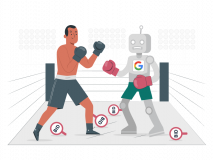I can summarize the problem with attribution for 99% of marketers today:
- Channel tracking overvalues individual marketing channels.
I.e., native tracking in Google Ads, Facebook Ads, Pinterest Ads, etc.
- Google Analytics undervalues interactions throughout the journey.
This is mainly because channel tracking tracks every single conversion back to the channel—no matter where in the journey or how many times a consumer interacted with an ad for that marketing channel.
Google Analytics, on the other hand, only tracks the final click. So, if a consumer has clicked on a Facebook Ad, a Google Ads ad, and an email, then only the marketing channel that received the last click will receive credit.
Today, we’ll try to debunk some of the most common attribution myths—some that are taken, at face value, for facts.
A bit of glossary before the article starts:
- Channel tracking = the tracking mechanism inside the ad channel itself. This can be the Facebook Pixel, Google Ads conversion tracking, etc.
- Revenue to Ad Spend Ratio (the RAS ratio) = Considered the guiding factor in all your marketing. It looks at your overall marketing spend vs. your total revenue.
- View Conversions = Users who have seen your ad and then converted but didn’t actually click on or engage with your ad.
How Tracking Works Across the Three Major Options
To get started, I want to make sure that everyone understands the differences between the main tracking mechanisms used by marketers today.
Channel tracking
Channel tracking can only track results from its own channel, so it completely ignores other touchpoints in the buying journey:
![]()
Google Analytics tracking
This is “last click” tracking.
Technically it’s “last non-direct interaction,” but, to keep it simple, we’ll use the “last click” terminology.
Channel Click → Channel 2 Click → Channel 3 Click → Purchase
Third-Party Attribution tracking
Channel Click → Channel 2 Click → Channel 3 Click → Purchase
This sounds ideal with third-party tracking, but the challenge is verifying the weight of each channel, and no software to date is able to follow a user through the entire customer journey all the time. So, the software will always be somewhat inaccurate.
Why Google Analytics Has Fooled a Generation of Marketers
The more I’ve learned about attribution since we founded SavvyRevenue in 2017, the more I dislike Google Analytics.
It looks to be this awesome place, where you can see your ROAS per marketing channel and have your finger on the pulse of everything.
But you can only use it for much if you work in SEO, Paid Search, or email marketing.
A client of ours ran a chat-bot on its site for a month. Paid Search performance tanked!
Or did it?
Nah, it was just that the chatbot was misconfigured, so when people clicked a link inside the chatbot, it triggered a new session, and the user was listed as being “referred” by the chatbot.
The same thing happens every single day with other channels.
Let’s use my own customer journey for my Allbirds.
I love the DTC market, so I see them mentioned from a marketing perspective frequently. I’ve seen their shoes several times, and friends have recommended them to me.
It took me a year to buy my first pair. Why? My wife didn’t like them, and I wasn’t sure they’d fit.
One day I received an email, and I loved a new pair they had: Wool Pipers.
And you know what? I hated them when I tried them on. They looked awful on my feet.
I returned them and thought that was it.
About six months later, I saw they had opened a store in San Diego, so I went in and tried all the shoes. I walked out with a pair of tree runners that I’ve loved ever since.
So, what was the actual deciding factor in me buying a pair of Allbirds?
- The ongoing Facebook Ads?
- The email with the Wool Piper shoes?
- The physical store?
- My friends’ recommendations?
- “Direct”?
Let’s quickly go through them:
- The ongoing Facebook Ads?
- Meh, I rarely clicked them, but they kept Allbirds top of mind.
- The email with the Wool Piper?
- It triggered the initial purchase, but I returned them immediately. So essentially, that return, if tracked properly, should negate my purchase.
- The store?
- Maybe, but how do you use that as a marketing channel?
- My friends’ recommendations?
- I honestly didn’t like the way the wool Allbirds looked, so besides them constantly telling me the fit was awesome, their recommendations weren’t really a deciding factor.
- “Direct”?
- I visited their site maybe 50 times before I bought the shoes. But I would never have visited the site if it weren’t for them piquing my interest elsewhere.
I have dozens of these stories. Whether it’s the Misen pans we have, which were introduced to me the first time because I spoke to their marketing manager, or the CNET article I read about my Logi MX3 Master mouse, or the inflight magazine eight years ago that introduced me to Untuckit shirts, which I never bought until—you guessed it—eight years later, as I passed the store in San Diego.
I love to bore our team at Savvy, or any new client who will listen, with my attribution stories because it’s so rare that your attribution is one-to-one if you sell a product that has more complexity than a scalp massager.
But back to my original proclamation:
Google Analytics has fooled marketers into thinking that attribution is a one-to-one event that can be tracked.
It can’t, and it shouldn’t.
So, by saying that Analytics is misleading, what should you do instead?
Channel Tracking as the Alternative
The easiest alternative is to use the tracking straight from the engines—meaning we use the tracking native to that channel (i.e., Google Ads, Facebook Ads, SnapAds, Pinterest Ads, Criteo, etc.).
The biggest benefit of this is that you get the biggest amount of data. Again, if we use the illustration from above, then no other channel “overrides” the native channels’ tracking.
So, any time that specific channel has a touchpoint with a user that ends up converting, it’ll track a conversion.
The other advantage is that you can use the platform’s native bidding mechanisms. For instance, without using the pixel tracking in Facebook Ads, the algorithm can’t really optimize for anything. You can’t import Google Analytics transactions, for instance, so you basically have to do it anyway.
But this is not without problems:
- Each channel gets 100% credit for a transaction.
- The same transaction is tracked multiple times.
- The tracking methodology is not the same.
Each Channel Gets 100% Credit
Let’s say someone clicked on a remarketing ad on the Google Display network. This results in one tracked conversion.
Most likely, that user will have visited your website through various means (from a Google ad, a Facebook ad, a review site, etc.).
Is it really fair that the remarketing campaigns receive full credit for generating that new customer?
Of course not. Remarketing should never receive 100% of the credit from a conversion. But that’s how channel tracking works.
That’s why it’s so difficult to defend channel tracking. From a marketer’s perspective, we want as much data as possible, but it’s tough to defend from a business perspective.
The Same Transaction is Tracked Multiple Times
With channel tracking, if a channel has a touchpoint with a user before he or she converts, the conversion will be tracked back to that channel.
This means that one transaction can be reported as individual conversions in each marketing channel:
- Google Ad Click.
- Facebook Ad Click.
- Organic Search Click (tracked in Analytics).
Three channels, three “conversions”, but one user buying something.
This is what client meetings from hell are built on.
Credit to Giphy
“You are showing 1,100 conversions last week from FB and Google Ads, but our backend had 1,200 in total. Did FB and Google really drive 90% of our conversions?”
Of course they didn’t. But there were touchpoints. The problem is just that each channel is taking 100% credit for the conversion.
Default Tracking Methodology is Not the Same
This is where people who aren’t living and breathing online marketing really seem to struggle. Understandably.
Each channel tracks a little bit differently as a default:
- Facebook Ads track one day view, and seven day click (it used to be 28 day view, 28 day click, before IOS 14)
- Facebook is really good at tracking users across devices
- Google Ads track 30 day click, never view
- Even the native Google Ads tracking can’t distribute conversions across the Search or Display networks
- Google Ads cannot track people across various devices
- Criteo tracks everything (I’m biased due to some unfortunate client experiences)
So, even when you know that each channel takes 100% credit for a transaction, it’s impossible to compare the channels to each other because their tracking methodologies are different.
Without the same methodology, you can’t really tell what works and what doesn’t. We’ve seen less sophisticated clients get reports from their Google Ads agency and Facebook Ads agency, compare the two and increase the budget for Facebook because it looked like it was performing better.
What About Third-Party Attribution Tools?
This is where it starts getting interesting. You might have even thought about it while reading this:
Why can’t we find a way to weigh each channel’s contribution to a final conversion?
The problem with these tools is that they can’t track users across the journey.
A journey can consist of being on a work computer, personal phone, tablet, and/or computer. I can also research the cooktop we’re buying next month but tell my wife to buy it by sending her a link via Facebook Messenger.
Many tools have tried tracking the entire journey, but especially with how much Apple, Firefox, and even Google has limited advertisers’ ability to track the same person across the web, it’s impossible to do so.
The solution?
Micro conversions.
Micro Conversions are the Inaccurate Science We Need
Micro conversions can be explained as such:
You provide a value to specify their actions on your website and use that to gauge each marketing channel’s performance.
For example, this could mean you look at all your converted users and try to backtrack what behavior they shared prior to converting.
You combine this with your best guess—or AI modelling—as to what other behaviors your customers will have engaged in prior to converting.
You then decide on your marketing activities based on these instead of based on final transactions.
Some of these micro conversions could be:
- TOFU marketing activities:
- Time spent on site vs.:
- Email submitted
- Product favorited
- Times visited
- Time spent on site vs.:
- MOFUmarketing activities:
- Add to Carts
- More frequent visits to the same products
- Key page visits (financing, comparisons, etc.)
- Chat initiated
- BOFU marketing activities:
- Purchases
- Send directions
One tool that is trying to do this is Segment Stream.
On the B2B front, DreamData.io is trying something similar.
The Importance of a Competent CMO
As you can see above, we’re no longer tracking transactions that can pay for our marketing. We can no longer look at our marketing spend and see the exact ROAS for each channel to verify that we’re not wasting our money.
But, as I’ve tried to depict today, we’ve never really been able to do that.
We’ve lied to ourselves about our data because we wanted it to be true. Let’s be honest. The flawed ways we’ve tracked online marketing so far are still a lot better than blasting push marketing without any idea what has worked and what hasn’t.
But this is where the return of the CMO comes in.
We can no longer just have specialists reporting their individual ROAS back to business leaders.
We need CMO’s who have a framework and experience that will result in growth.
Attribution as a Reflection of Your Business Stage
Based on this, it would seem that everyone should jump on the micro conversion bandwagon.
The challenge is that, as of today, it’s not super easy to set up. Also, it requires a good amount of data, and experience, to set up correctly.
In the early stages of your company, you don’t have this.
My recommendation is that companies at various stages of their business use different tracking mechanisms:
- Early-stage: Last click, primarily
- Mid-stage: Channel specific
- Late-stage: Holistic / third party
“We see attribution as a growth mechanism that follows a brand’s growth journey.”
In the early stage, every penny counts, and it is paramount to only spend money where you are 100% certain you will be getting immediate money back. So, using Google Analytics data will drive the most bang for your buck.
As you start maxing out your marketing channels using Google Analytics tracking, you also start being more profitable. You get more traffic that you can’t track (i.e., direct traffic), and you realize that you’re missing important growth opportunities. This is when you make the switch to channel tracking.
But once you run five, six, seven, eight marketing channels + TV, you start having an issue with transactions being reported multiple times—hence, overvaluing individual channels. You need a new guiding principle, and that’s when you start looking at micro conversions and your overall ad spend to revenue ratio.
The Most Successful Ecommerce Business Do This
“We can’t pay our bills with clicks.”
This is the response everyone should have when they hear about micro conversions.
The most successful e-commerce businesses I’ve worked with use a Revenue to Ad Spend ratio (RAS) to determine whether their marketing is working or not.
Some call this their cost of sale. For others, it’s their marketing efficiency. In the early days, you’d use your overall revenue to define your marketing budget.
You’d say established companies should spend 5–10% of their revenue on marketing, while growing companies should spend 10–15% of their revenue on marketing.
This is what I’ve seen the most successful e-commerce companies do.
Summarizing the Options
1) Use Google Analytics and be heavily focused on P&L at the expense of growth.
2) Use Google Analytics, but set the targets “low,” knowing that you’re undervaluing specific channels. Then use channel tracking balanced out with Google Analytics tracking.
3) Set an overall RAS ratio target, use channel tracking (like Google Ads, Facebook Ads, email software, etc.), and balance your ROAS targets in each channel to how much you actually value the channel.
4) Choose an attribution tool (like SegmentStream) and use it to help guide your targets for individual channels.
Other honorable mentions include:
- Facebook Attribution appeared to be a good try by Facebook, but it hasn’t gotten to the stage of being able to include all channels.
- I was super excited about Google Attribution, but it never really solved the actual problem.
- Analytics 360 (previously Google Analytics Premium) costs about a million USD a year. So, no.
Whatever You Choose, It’s Wrong
Whatever option we choose, it’s “wrong.” None of the options take the full picture into account. No option exists that is perfect or even near perfect.
Going with Google Analytics will highly skew your marketing dollars towards channels and campaigns that are focused on the bottom of the funnel.
Going with channel tracking, without balancing the ROAS targets for the fact that each channel will overvalue its contribution, will lead you to bankruptcy faster than short selling Gamestop stock.
What you can do is choose an “attribution methodology” that fits your business stage and let that guide your marketing decisions.








7 thoughts on “Why Attribution is an Inaccurate Science in eCommerce and What to Do Instead”
This article got me thinking. With AdWords i’ve often heard it’s good to add micro-conversions. Add to cart, sign up, etc. I’ve never gone down this path because I’m a bit old school. I’m also not hesitant as I don’t want Google to prioritize signs up (for example). I was sales to be the main driver for clicks.
What is your experience? To put things in perspective I still have manual bidding but most of my shopping campaigns used enhanced CPC.
Hey Besh, that’s a good point. You can easily “NOT INCLUDE” them as conversions, so your bidding strategy wouldn’t optimize around those conversions, yet still preserve the data.
Question is how exactly are we going to layer the micro-conversions between the channels, and what will it tell us? How much of an influence each channel is to a particular action?
P.S. As always, Andrew, thanks for a great article.
Also, this article is a perfect illustration of how “oversold” this world of AI is, really. Nothing is streamlined, nothing is perfectly synchronized in the reality. Do not trust “marketers” who sell a perfect solution to the attribution problem. Always take it with a grain of salt.
for Google Ads, Brand Search is a typical ‘Black Hole’ for attribution/conversion value, right? So why not move Brand Search to its own account, or break off from your MCC, if you have one… as well as unlink from GA. Let’s not let brand search fool us any more.
Exactly! We spoke about this in a separate article, but I wholeheartedly agree.
Hello Andrew,
Loved this article.
What do you think about GA4 attribution modelling, and specifically Data-driven model?
Does it solve anything?
Hey Jaume,
Thanks!
Nah, it’s still an inaccurate science albeit data driven attribution modelling is much better than just running last click in Universal Analytics.
But it’s still inaccurate, and I would stay by my recommendation in the article 🙂